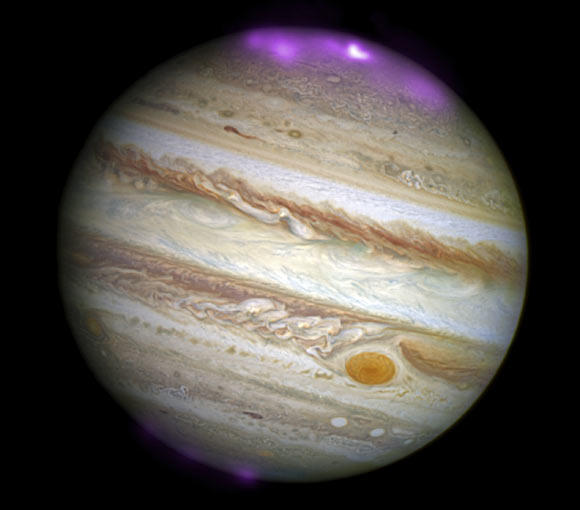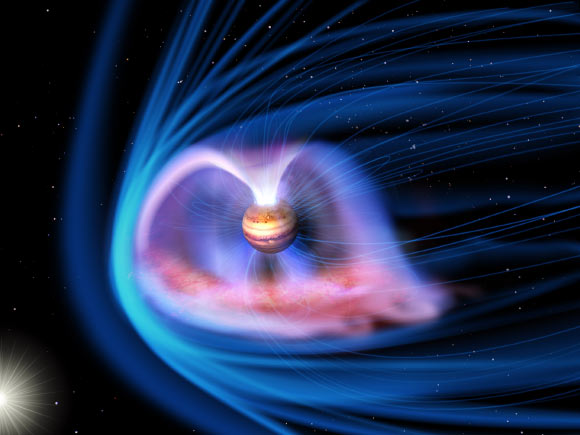According to a study led by University College London researcher William Dunn, the solar wind is causing intense X-ray bursts over Jupiter’s polar regions.

Solar storms are triggering X-ray auroras on Jupiter that are about 8 times brighter than normal over a large area of the planet. These Jovian auroras are hundreds of times more energetic than Earth’s aurora borealis. This composite image with data from NASA’s Chandra and Hubble shows Jupiter and its aurora during a giant solar storm on October 2, 2011. Image credit: X-ray – NASA / CXC / UCL / W. Dunn et al.; optical – NASA / STScI.
Auroras are caused by charged particles hitting a planet’s atmosphere at high speed, visible as aurora borealis or aurora australis (Northern or Southern Lights) on Earth.
Jupiter also has auroras but these are invisible to the eye because they lie in the UV and X-ray portions of the spectrum.
Now, by using data from three satellites measuring Jupiter’s space environment, Dunn and his colleagues from Japan, the United States, UK, and France found out what causes this aurora.
The team discovered that the acceleration necessary for Jupiter’s X-ray aurora is triggered by the solar wind.
Detailed analysis of the X-ray emissions also show that they peak in regions closest to the outer edges of the gas giant’s magnetosphere, where the interaction with the solar wind would be strongest.
“The Sun constantly ejects streams of particles into space in the solar wind,” the scientists explained.
“When giant storms erupt, the winds become much stronger and compress Jupiter’s magnetosphere, shifting its boundary with the solar wind 2 million km through space.”
“We found that this interaction at the boundary triggers the high energy X-rays in Jupiter’s Northern Lights, which cover an area bigger than the surface of the Earth.”
The impact of solar storms on Jupiter’s aurora was tracked by monitoring the X-rays emitted during two observations in October 2011 when an interplanetary coronal mass ejection was predicted to reach the gas giant from the Sun.
Dunn and co-authors used the data collected to build a spherical image to pinpoint the source of the X-ray activity and identify areas to investigate further at different time points.
The results were published online March 22 in the Journal of Geophysical Research.
“Comparing new findings from Jupiter with what is already known for Earth will help explain how space weather is driven by the solar wind interacting with Earth’s magnetosphere,” said co-authors Prof. Graziella Branduardi-Raymont, also from University College London.
“New insights into how Jupiter’s atmosphere is influenced by the Sun will help us characterize the atmospheres of exoplanets, giving us clues about whether a planet is likely to support life as we know it.”
_____
William R. Dunn et al. The impact of an ICME on the Jovian X-ray aurora. Journal of Geophysical Research, published online March 22, 2016; doi: 10.1002/2015JA021888








